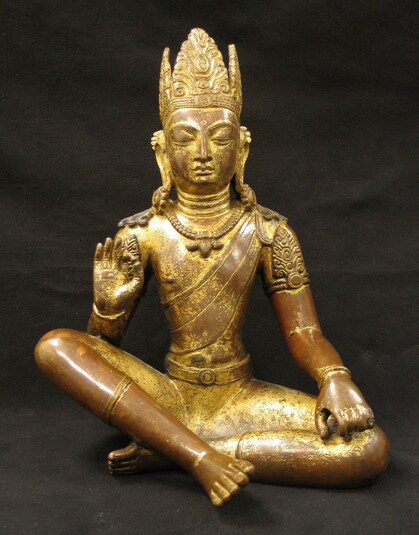
Item: Manjushri (Bodhisattva & Buddhist Deity) - Bodhisattva
| Origin Location | Nepal |
|---|---|
| Date Range | 900 - 999 |
| Lineages | Buddhist |
| Material | Metal, Mercuric Gild, Painted Face/Hair |
| Collection | Nyingjei Lam |
Classification: Deity
Appearance: Peaceful
Gender: Male
Manjushri in a relaxed posture.
With half closed eyes as if in meditation Manjushri gazes forward. The right hand is held upraised with the forearm resting on the thigh. The thumb and index finger delicately display a seed. The left hand rests on the knee while he sits in a relaxed posture. Atop the head is a tall crown with three leaves along with earrings and ribbons, a short choker necklace sometimes referred to as a 'tiger claw' design, armlets, bracelets, and anklets. He wears a short lower garment tied with a belt
The identification of the figure as Manjushri rather than another known Buddhist figure is primarily informed by the seed held in the right hand. A secondary characteristic is the 'tiger claw' necklace, although other Buddhist characters from the Mahayana Sutra literature can also be found with a similar necklace. Figures such as this are also identified by what characteristics are not found, such as there is no Amitabha Buddha on the crown, no lotus blossom and no deerskin draped across the left shoulder. Lacking these characteristics will generally rule out an identification of Lokeshvara. If there is no vajra scepter held in the right or left hand then Vajrapani is ruled out. Without a Dharma wheel, water flask and stupa, then Maitreya is ruled out.
For this figure identified as Manjushri there are two characteristics that are noteworthy, the seed and the 'tiger claw' necklace followed by the lack of any other identifiable and well known attributes.
Manjushri (Tibetan: Jampalyang, Jampaiyang (rje btsun 'jam pa'i dbyangs) is a popular Buddhist figure commonly represented in art. He first arises from the Mahayana Sutra literature of Northern Buddhism where he is regarded as a bodhisattva - the bodhisattva of wisdom. In artistic depictions these forms are non-iconic in appearance which means that the iconography is not fixed. Manjushri will still have one face and two arms. His typical emblem is a Prajnaparamita sutra book held in the left hand or supported by a flower blossom. A sword is often held in the right hand. In art he is typically depicted in a relaxed posture, in front of a temple or portrayed in narrative settings.
In the Tantric literature of Northern Buddhism Manjushri is seen as a completely enlightened Buddha with a great number of manifestations and appearances spanning all four classes of Tantra, simple and complex in form. From the Eleven Figurative Forms Manjushri is represented in Peaceful, Semi-peaceful, Wrathful and Animal Featured. All of the Tantric forms are Iconic in Appearance. This means that the descriptive forms are static in appearance. The iconography is set as to the appearance type, colour, number of faces, arms and the attributes held in the hands along with the retinue figures.
Jeff Watt [added 8-2019]
Exhibition: Wutaishan, Pilgrimage to Five Peak Mountain
Thematic Sets
Buddhist Deity: Manjushri Sculpture Page
Subject: Iconic & Non-iconic Figures Main Page
Buddhist Deity: Bodhisattva (Masterworks)
Collection of Nyingjei Lam (Bonhams, HK 2019)
Buddhist Deity: Manjushri, Bodhisattva (Sculpture Masterworks)
Nepal: Transitional Period Sculpture & Style
Buddhist Deity: Manjushri (Sculpture Masterworks)
Collection of Nyingjei Lam (Deities)
Sculpture: Famous Works
Sculpture: Monastic Period, Nepalese Schools (11th Century)
Buddhist Deity: Manjushri (Holding an Object)
Sculpture: Transitional Period (Nepal Atelier)
Subject: Tiger Claw Necklace
Sculpture: Style Names, Region & Artist
Buddhist Deity: Manjushri Source Texts, Sutra (84000: Translating the Words of the Buddha)
Buddhist Deity: Manjushri, Rare & Unusual Forms
Buddhist Deity: Manjushri Main Page
Collection of Nyingjei Lam
Buddhist Deity: Manjushri (Non-iconic Forms)

